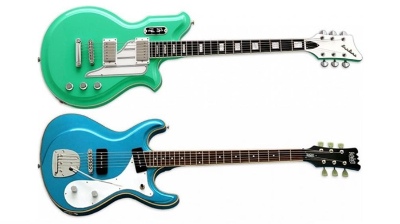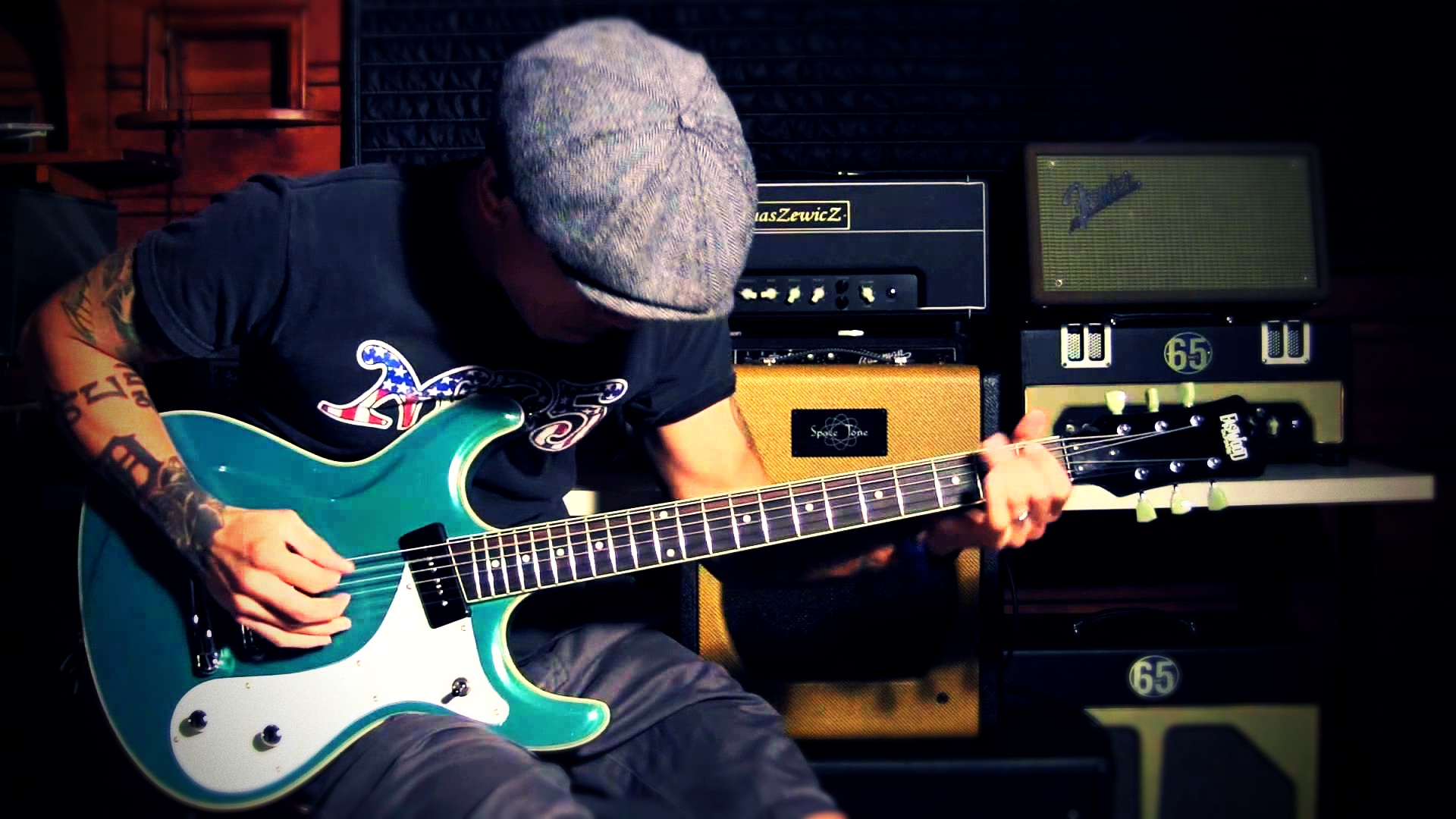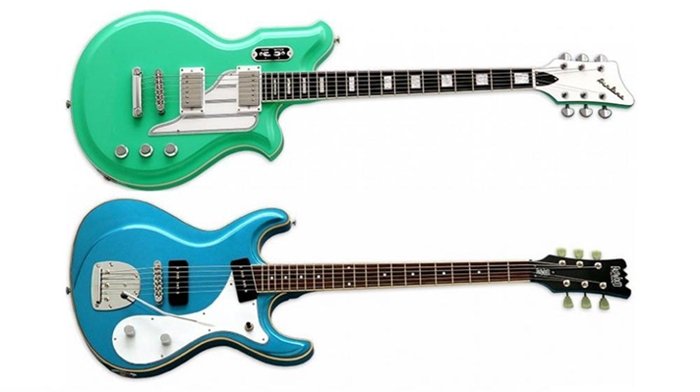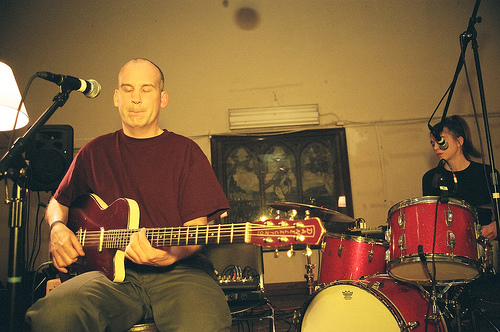
One of the best selling models from Eastwood Guitars is the Sidejack Baritone. More recently they have also introduced the Airline MAP Baritone. Why are they so popular? First, let’s take a look at what a Baritone guitar is.

Simply put, they are exactly the same as any standard electric guitar but with a lower voice. A standard guitars tuning (from lowest string to highest) is E A D G B E. Baritone guitars are usually tuned a fifth lower (A D G C E A), or a fourth lower (B E A D F♯ B). Therefore, all the chord patterns you already know are exactly the same on a baritone, but simply produce a lower voice.
Why use a baritone when I can tune my standard guitar lower?
“So why not just take my trusty Fender and tune it lower?” you might ask. If you did, you’ll find the strings to be too “floppy” and not enough tension to produce a useable sound. The solution? Make the neck longer and use heavier strings. More precisely, make the “scale length” longer and use heavier strings. What is the scale length?
 Airline Baritone Guitar & Eastwood Baritone Guitar
Airline Baritone Guitar & Eastwood Baritone Guitar
The scale length is the precise length of the suspended string, the length between the nut and the bridge. Generally speaking, most Gibson style guitars have a 24 ¾” scale and most Fender style guitars have a 25 1/2” scale. String sets of 10-46 gauge are typical for these guitars tuned E-E. On the other end, tuned a full octave below the standard guitar at E-E, a Fender Bass has a scale length of 34” and strings in the 45-100 range. Eastwood produces a number of “short scale” bass models, with a 30 ½” and 32” scale, also with the 45-100 string sets.
Most Baritone guitars fit in the middle and have a scale length ranging from 27” to 28”. Eastwood’s Sidejack Baritone has a 27” scale and uses D’addario Baritone Light strings, 13-62, tuned B-B.
Tension Chart
|
|||||||||||||||||||||||||||||||||||||||||||||||||||||||||
Why is a baritone guitar useful and why should I buy one?
OK, with all that technical stuff out of the way, the next question, “why is a baritone useful and why should I buy one?” The real advantage is that ANY guitar player can pick one up and be an expert baritone player immediately as the tuning is identical to their standard guitar, just lower. So every chord pattern you play is identical on the baritone.
For example, when you play an open E chord on your guitar, you’ll do exactly the same on your Eastwood baritone, but it will be an open B. Get it? So you can play any song or riff you already know, right out of the box, but you’ll notice a darker, more haunting texture in your tone.
Jeff Senn Model One Baritone Demo
The Jeff Senn Model One Baritone is a new Eastwood Custom Shop model, and one of those guitars that really could tip you into falling in love with baritones! VIEW MODEL ONE BARITONE INFO
NEW: Classic 6 Baritone semi-acoustic
Truth be told, baritone guitars are still a little bit of a niche, though not as much as it used to be, and we’ve notice a steady increase in the number of users over the years. But still, you won’t find many semi-acoustic models available out there, which makes this recent Eastwood Custom Shop very appealing: Imagine a George Harrison Country Gent-style guitar… but with longer scale for a slightly darker tone! Sounds amazing… at the moment, the Eastwood Customs Classic 6 Baritone is a crowdfunding project, and those interested need only leave a small deposit to guarantee theirs and make sure the guitar gets made.
A brief history of… Baritone guitars
Next, let’s take a look at the history behind the baritone. Danelectro was the first to introduce the electric baritone guitar in the late 1950s where it soon appeared in a lot of 60’s surf music as well as background music for many movie soundtracks, especially spaghetti westerns. These days you’ll hear baritone in all types of music from folk to rock to heavy metal. The voice of the baritone is low enough to stand out in the mix next to a standard guitar and is high enough to cut through well above the bass.

Ian McKeye and his baritone guitar, live with The Evens
Brian Wilson used baritones often in his arrangements with the Beach Boys. Glen Campbell used them in great songs like Wichita Lineman. Ian Mackaye from Minor Threat uses a Sidejack baritone with his band The Evens. Jazz guitarist Pat Metheny uses baritones in his arsenal of guitars. Pat Smear of the Foo Fighters also uses a Sidejack Baritone. Colin Newman of Wire (who came up with the idea) uses the Airline MAP Baritone. The great Richard Hawley (can you tell I’m a big fan?) uses a Sidejack Baritone on his recordings, many of which were inspired by one of the earliest adopters of the baritone, the fabulous Duane Eddy.
If you have a studio, you really NEED a baritone electric. You won’t have to invest any time in learning to play it and you will quickly discover many useful applications. Eastwood produces a few variations and price points to suit every need. The Sidejack Standard and Deluxe baritones are under $500, great bang for the buck. The new Airline MAP and MAP DLX are killer baritones and come in under $900.
OK… How does a baritone guitar sound?
Here is a great example, where RJ Ronquillo rearranges Wrecking Ball by Miley Cyrus using the new Airline MAP DLX Baritone. The result is a deep, dark, beautifully haunting and more tearful composition than the original – “stripped” down to just a Baritone, without the need for gratuitous nudity.
Check out RJ here again, riffing along with his Sidejack Baritone giving “Hey Joe” a darker bluesy vibe, then showing the versatility of a baritone in surf and western styles.
Here is Lance Keltner taking a Sidejack Baritone for a spin with his band. Note the clarity when played along with a Stormbird Bass.
The baritone is also very useful when paired with a wide variety of effects:
..and with a little dirt too to give you that garage rock sound.
..and you can have hours of fun driving the baritone through GuitarRig 4:
So there you have it. Starting at just $429, it’s time to jump on the baritone bandwagon! Take home one of Eastwood’s family of baritone guitars and add some punch to your playing and recording endeavors. You’ll be glad you did.
update Oct 5/2014: here is a link to a recent Premier Guitar review of the Airline MAP Baritone:
http://www.premierguitar.com/
Also just announced the MAP Baritone received the 2014 “Premier Gear Award”




I bought a baritone about ten years ago and it has turned up on many of my studio recordings. Sometimes I’ll use it for a counter-melody line, sometimes I’ll use it for a lead break. And people notice. They’re like “what is that?” when it comes along in the song. I’m trying to find a way to work it in to the live set. And I’m saving up for a Sidejack just cause they look so cool. DH
Would it be smart to get a baritone for the use of d standard tuning
Ok, so using the same gauge and detuning is silly. But what about using heavier strings on a 25 ½” scale guitar and detuning? Are there practical (you’re seriously damaging the neck) issues, or would i just not be as cool?
Either answer is fine. I want an excuse to expand my collection anyhow. I still have room in my guitar closet for one more!
You will find that the string tension is far too low and the strings become “flappy” and buzz all the way up. That its why thelonge rscale is critical.
I thot Glenn Cambell used a “Bass-6” for Wichita and Galveston…is a “Bass-6” the same as a baritone? Also, do you make the baritone in “lefty”, Poncho?
I want a stormbird like that. I play everything in D anyway. Maybe that’s why it’s called stoner rock? Newer stuff like The atomic bitchwax,fu manchu,nebula, or even old motley crue. It’s got alot of GRRRRR in the sound that I can’t duplicate quite right with any amp or effects. I don’t think those guy’s use one but it just brings more to the party!
I built myself a Baritone V with Trem. What can’t I do with it. It’s one instrument that I can get to sound like a funk bass to a screaming lead machine. Baritone is the new Black. Get one, get low and get boogyin’.
The real question is, “Why would anyone think about *not* needing a SideJack?”
The Sidejack baritone is not a novelty item – it will revolutionize your songwriting style.
The brilliant, crisp and clear tone it produces is suitable for a wide range of music – and not just pleasant stuff. We use it for punk and Sonic-Youth-type stuff and it is perfect straight out of the box – far better than the Fender Tele baritone and Hagstrom Viking, both of which feature disappointingly muddy-sounding humbuckers in the bridge position.
And no, ShiceSquad does not work for Eastwood. But the Eastwood Sidejack does work for ShiceSquad!
As I wrote on my website:
“Fender created a six-string bass in the 1960s called the Bass VI, which is often considered a type of baritone guitar. (Here’s a good article on the Bass VI at http://www.vintageguitar.com) It is tuned an octave below a standard guitar, so it is similar to a four-string bass, except it has two additional strings at the high end (B and E). The scale length is typically 30 inches, and the neck width is narrow compared to most basses. I have a Schecter version of the Bass VI, the Hellcat VI, and I find it very cool and useful, but in my opinion, Bass VI style instruments should be considered a type of bass guitar, not a baritone guitar. The design attempt was to make a bass that felt familiar to players of standard guitars. (Reportedly John Lennon and George Harrison used a Bass VI to play bass with the Beatles when McCartney played piano.) My understanding of the intent of the baritone is to create an instrument for the pitch range in between the standard guitar and bass.
Even the staff at Fender seem to be confused about the difference between Bass VI-style instruments and baritones. Their Jaguar baritone is described as being a Bass VI type instrument but it is tuned to B and has a 27″ inch scale which makes it a baritone, not a Bass VI type instrument. In fact, Fender has a Bass XI reissue instrument available that has a 30.3″ scale.”
http://www.thebaritoneguitar.com/
Thanks to this article and some other research, I determined that the Danelectros from the 1950s were Bass VI type instruments, not baritones.
I’ve been using a baritone for almost a decade. What won me over was playing It’s Only Rock ‘n’ Roll wiht it. The sound is something akin to cannon balls dropping out of a Harley’s tailpipe. We strongly recommend baritones.
I read a lot of interesting articles here. Probably you spend a lot of time
writing, i know how to save you a lot of time, there is an online
tool that creates readable, google friendly articles in seconds,
just type in google – laranitas free content source
RE: “..Colin Newman of Wire (who came up with the idea) uses the Airline MAP Baritone”.
Uh, came up with WHAT idea, exactly? There was no reference about a concept or technique, prior to this comment. Just a list of people who play Baritones. Believe a sentence was left-out of the piece.
Mind filling us in on Colin’s ‘discovery’?
Colin has been using an Eastwood MAP guitar for many years. He suggested creating a Baritone version of it. So we did.
I recently get to know about the existence of the baritone guitar, and I’m planning to get one in the next couple of months, but I think the Fender Bass VI and Danelectro should be considered baritone guitars, since real basses are tuned symmetrically, for example 5 string bases are tuned B E A D G and 6 strings regular bases are tuned B E A D G C, a baritone guitar is tuned as a standard guitar, with a first and second string asymmetric with the rest, which are the tuning expected for the Bass Vi and Danelectro, even if a page that explain what they are says they are “Bass Vi type instruments”, besides, I doubting about getting a dark enough tone for bass lines with such a short scale length, but never tried it, can’t say for sure.
In other topic, I’m thinking on getting Fender Bass VI but instead of having the strings it comes with (.024 to .084) which should be tuned one octave lower than a standard guitar, I would change the gauge to .014 to .068, that setting would have the advantage of the 30″ scale or the tone but it can be tuned in standard B, my guess is it would sound nice.
Great article! I would also offer the Reverend HC Baritone (http://www.baritoneguitar.org/… for your list, a great instrument at $999. We have a review over at http://www.baritoneguitar.org/. We also have several other acoustic and electric baritone reviews.
I know that this is an old page, but see a bunch of questions about thicker strings on a normal scale that I may be able to help someone with in the future.
I have a 25″ scale Ibanez guitar that I put the heaviest strings I could find on (I think .62-.13s) to get a deeper sound. I can get down to drop-C tuning (CGCFAD) before the strings stop sounding like a guitar and start sounding like mud. With the extra scale length you can extend that quite a bit farther down.
Yes, you will need a set up. The difference in string tension and thickness means that your neck may need a truss adjustment and your intonation will need to be fine tuned. In my case, I also needed to slightly file the nut for the lowest two strings to fit. Your mileage may vary.
Beautiful sounding guitars.
I recently bought a baritone that I have tuned to “a” as the thickest string because I love the deeper sound. I have transposed and found the natural chords but do not know how to get the 7ths and flats. Can anyone guide me to a chord chart.
So I hear all of this but I still cant square it with the fact that in the 70’s Tony Iommi detuned a standard 6 string electric down to C#, AND put in lighter gauge strings to accommodate , and still managed to have a great sound. I know he had to fiddle with tuning but I am not hearing buzzing or wobbling. It might have enhanced his vibrato in fact.
I’m looking in to buying a Baritone but still not convinced its really necessary…thoughts?